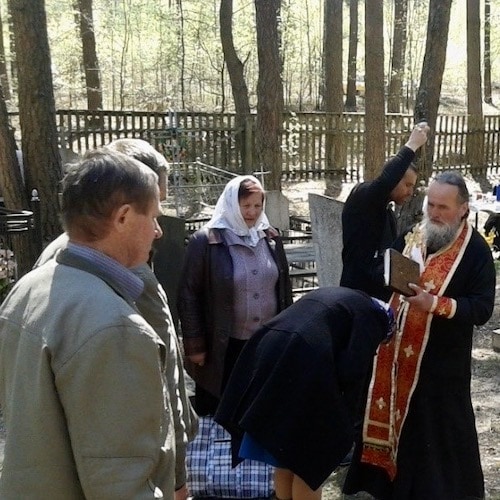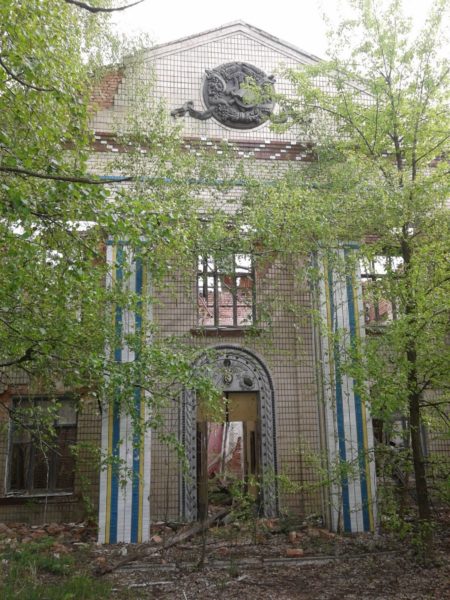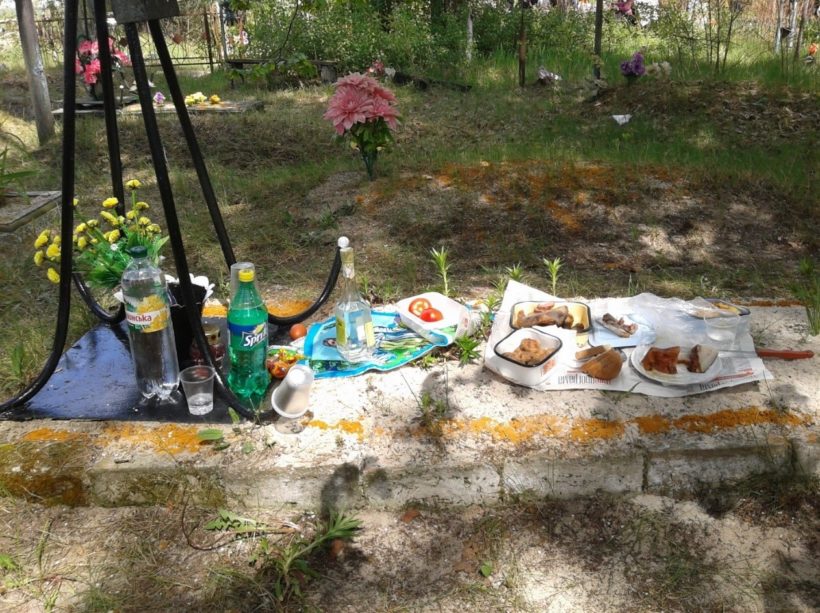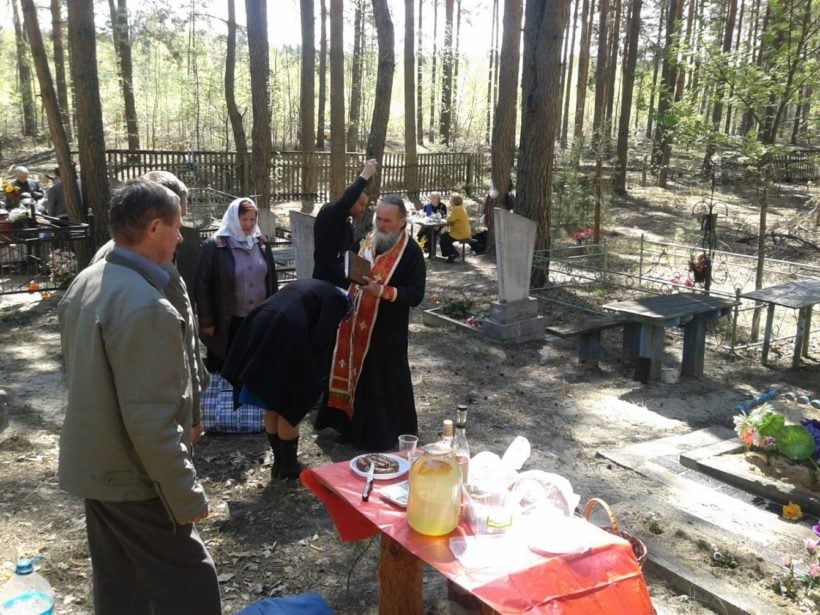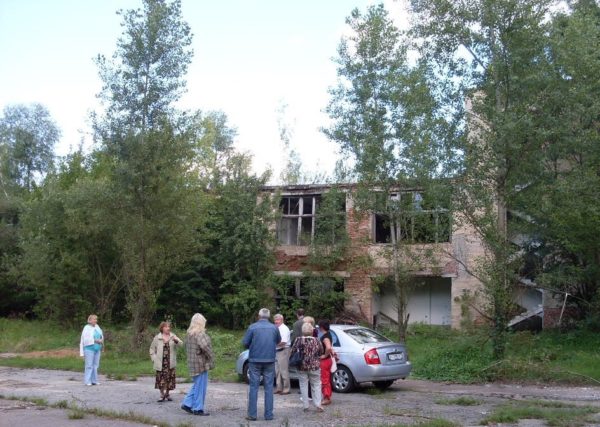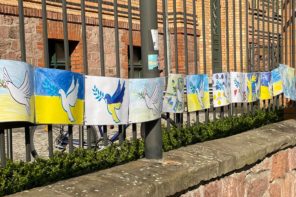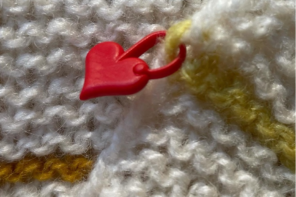Every year, after Easter, hundreds of families from all over Ukraine gather in the Chernobyl Zone of Alienation. People converge toward the now-deserted area to perform rites called hrobky, whose main feature is a family meal on the graves where their kin are buried. These rites are not exclusive to the Chernobyl-affected regions of Ukraine, as analogous practices constitute part of the Easter ritual complex across the whole of Orthodox Christian Eastern Europe. However, the hrobky performed in the Chernobyl Zone are unique in light of the peculiar landscape of loss and remembrance in which they are carried out – and the special moral salience that those commemorative banquets have come to carry for the uprooted and scattered community of Chernobyl pereselentsy, or evacuees.
Seen from afar, the Zone of Alienation stands out for its extreme otherness: first and foremost, as a geography of emergency and hazard, and secondarily as a hub for ruin porn and extreme tourism. However, those who were born here and their descendants relate to the Zone quite differently. The pereselentsy talk about this deserted landscape as their ridnyi kray or “native land/territory”: a space defined by now feelings of displacement and longing, on the one hand, and the ethical obligations of remembrance and care, on the other. Performing the hrobky on the ancestral graves is perhaps paramount among these obligations.
Early in my fieldwork in the Chernobyl-affected regions, I noticed that the cemeteries attached to ghost towns and villages were among the best-preserved structures in the Zone after the power plant itself and related infrastructures. In the case of cemeteries, however, maintenance is provided not by state apparatuses but by members of formerly residential communities that have long been displaced. Most graves are tidy and well kept. Crosses sport colourful flower wreaths, often made of plastic. Weathered, faded or torn wreaths are few and far between: the overwhelming majority appear to be regularly replaced or dusted. My interlocutors confirmed that most cemeteries in the Zone are regularly attended to. Authorities have established dates on which access to the Zone, normally forbidden, is officially permitted in order for pereselentsy to come back and fulfil what they describe as the moral duty of cleaning and tidying burial spaces. The week after Easter is one of such special windows of possibility.
The hrobky
On the day of the hrobky, visitors’ first priority is cleaning up the tombs. The burial grounds, located in leafy groves at a certain distance from the decaying, overgrown settlements, reproduce to a degree the social order of the long-gone abodes of the living, with burial sites usually grouped by kinship. Many family tomb clusters are fenced by metal railings. Each fenced patch includes a few graves, benches, and often a wooden table. Upon arrival, attendees immediately start removing overgrowth and debris, weeding the spaces between tombs, straightening lopsided crosses, mending broken benches, or painting rusty railings.
What matters is not whether ritualists literally feed their ancestors, but that they deem it important to recognise them.
The festive meal (trapeza) on the tombs of dead kin follows. This is the apex of the hrobky. Glasses are raised to the memory of the deceased (usually vodka for men, sweet wine for women), with toasts being offered at least three times during meals. The deceased “partake” in the feast: colourful decorated eggs, sweets, a slice of Easter focaccia bread, and a shot-glass of vodka are left on the grave, often on hand-made embroidered towels (rushnyky) bearing religious motives.
Do hrobky-goers “really believe” that the dead feed on their offerings? Put in those terms, such a question would be ill-posed. As Katherine Verdery put it, what matters is not whether ritualists (think that they) literally feed their ancestors, but that they deem it important to recognise them (1999: 46): “In places that take ancestors seriously, […] the relations of living and dead are maintained through commensality” (1999: 140). Taking the dead seriously, here, is a moral posture rather than an ontological one.
Frequently, the festive bread and eggs have been blessed during the Easter service. For those who so desire, a priest may bless family tombs by waving incense over them and singing Easter prayers: “Christ is risen from the dead, trampling down death by death, and upon those in the tombs bestowing life…”
During and after the meal, the community gets together, friends and acquaintances catch up and exchange a few words, acquainted families exchange food and join toasts. Each funerary patch, fenced-in or not, is configured as a domestic place – sviyi (“one’s own”). Such lots operate like and are sometimes referred to as an open khata (“house”): passers-by may be hailed, and those who linger for a brief chat may be asked to come in and sit down to be treated to home-made delicacies, wine, or vodka.
Once the hrobky proper are concluded, many attendees move out of the burial grounds. By car or on foot, people head to the abandoned streets of nearby ghost villages, embarking on a secular yet highly ritualised “pilgrimage” toward what remains of their “native places” (ridni mistsya), hollowed out after the Chernobyl disaster. Some move in groups, reminiscing about town and neighbourhood life, recalling “how it was before,” or taking pictures of empty buildings, collapsed roofs, and silent windows. Some pereselentsy prefer to remain alone with their recollections. One of them, Auntie Lena, once brought me to the ruins of her childhood house after the hrobky, “to make me understand” what it was like to live in the wake of such a loss.
Despite the haunting return of painful memories, the hrobky are not solely defined by a mournful atmosphere: a distinct effervescence runs through the crowd. Under the solemn tree canopies, the air vibrates with the chatting of old friends, jokes, barely repressed laughter, the smell of holiday food, the bright colours of women’s shawls. The joy of meeting ridni lyudy (“close relations, kin;” by extension, “people close to one’s heart” including non-kin) and returning to the ridnyi kray is almost tangible. Cheerfulness, however, must be mitigated by a respectful behaviour toward the departed and toward the ruins themselves, silent witnesses of a great tragedy that has never really passed.
The morality of remembrance
The Easter funerary rites provide an opportunity to visit not only the dead, but also the elderly settlers (samosely) who still reside in the Zone of Alienation: several hrobky-goers take advantage of the trip to keep them company and supply them with goods. Gift-exchanges also take place among hrobky-goers: on one occasion, my interlocutor Dmytro, a middle-aged man who dabbled in versification, brought with him a cardboard box full of poetry books to donate to acquaintances and friends. Other gestures of generosity and care are directed towards those who are absent: Auntie Lena, for instance, once cleaned up the lonely tomb of a child whose relatives had been unable to travel to the Zone.
Ritual, thus, fosters conviviality and kindness. An ethos of heightened solidarity emerges with particular intensity at the very core of the community’s memory landscape, the burial grounds: showing that places that function “as mnemonic devices recalling shared history” may also act as “moral guides for current behaviours” (Kahn 1996: 195). To remember and to care, Michael Lambek has observed, are synonyms “in several senses of the word: to care for and to care about; but also to take care of someone; to take care, as in to be careful; to have cares, as to be full of care” (2007: 220). All of these nuances converge at the hrobky.
Hrobky-goers explicitly described the Easter rituals as a cornerstone of a memory architecture that is built from the bottom up, alongside the “official” memory of state rhetoric.
What makes the cemeteries in the Zone such powerful affective and moral magnets? At the hrobky, vernacular Orthodoxy, filial piety toward the departed ancestors (predki), and a commitment to the cherished native land (near-sacralised through poetry, literature, and art), combine with an imperative that has come to define the pereselentsy’s post-disaster lives: the imperative of remembrance (pamyataty). Many hrobky-goers explicitly described the Easter rituals as a cornerstone of a memory architecture that is built from the bottom up, alongside the “official” memory of state rhetoric. In the words of my interlocutor Ira:
[Chernobyl] was a tragedy, you know, a true calamity (hore). This is the story of an unbearable pain. We come here [to the hrobky] to keep the memory alive in our hearts; it’s so painful (bolyache), such an unspeakable longing (tuha) and anguish (tryvoha). But it is important not to forget, to protect memory, to pass this memory on to the new generations. It’s vital to explain, to tell, to remember.According to Ira – who had brought her teenage son Sasha to the hrobky – handing down memory to the new generations was of utmost importance. Such conviction is shared across the evacuee diaspora: many of my interlocutors stressed the considerable economic and logistical effort (and – to a lesser extent – the risks) involved in traveling to the Zone for the hrobky. But, “whether one wants it or not, it is our duty to go.”
A heterotopic afterlife
While the evacuee diaspora has created several lieux de mémoire outside the Chernobyl Zone, such as community-sponsored museums and monuments, such sites do not supplant the cemeteries in the Zone as mnemonic devices, moral catalysts, objects of care, or settings for collective rituals. To capture, at least in part, what makes the Zone’s burial grounds irreplaceable in the eyes of the evacuees, I frame these sites’ post-catastrophic vitality in the terms of a heterotopic afterlife.
Michel Foucault famously defined heterotopias as places where the “sites that can be found within [a given] culture are simultaneously represented […] and inverted” (1984: 3). Such a definition can be applied to the Chernobyl Zone as such: Chernobyl upended the pre-disaster landscape, preserving the “native land’s” physical layout while turning its familiar tapestry of villages and towns into a mournful ruinscape. Heterotopias, stated Foucault, often imply heterochronies, i.e., breaks with the established organisation of time that seem uncanny and familiar at once. The Zone’s unique temporal qualities – its haunting stillness, its crumbling ghost towns, its weathered Soviet monuments, as well as the mnemonic encrustations of evacuees’ past lives – are well captured by this concept.
Burial grounds revert the alienated space of the Zone by reevoking the inalienable landscape of the native land.
According to Foucault, cemeteries constitute a specific type of heterotopia (1984: 5): burial grounds are “other” in respect to the ordinary social spaces of the living, yet they carry the traces of past lives into the present. The cemeteries of the Chernobyl Zone can thus be conceived of as heterotopias nested within another heterotopia. Burial grounds revert the alienated space of the Zone by reevoking the inalienable landscape of the native land, with its web of kinship and neighbourly relations crystallised in cemeteries’ layout. This reversal might not annul the uncanny mournfulness of the Zone, but it lends tangibility and vitality to the nostalgic geography of the ridnyi kray. Heterochronically, cemetery-based activities puncture the deserted stillness of the Zone with the pulsation of unbroken, cyclical human presence and care. This emerges with particular intensity during the highly ritualised moment of the hrobky, when the pereselentsy join in a well-rehearsed choreography that lends this scattered diaspora a feeling of togetherness as a moral community united by belonging to the same kray.
On burial grounds, the Zone of Alienation’s geography of mourning and the memory-laden geography of the ridnyi kray coincide like nowhere else. The heterotopic vitality of cemeteries in the Zone is testament to the “native land’s” post-disaster perdurance and inalienability. By infusing these sites with vitality through the hrobky, Chernobyl survivors ensure a form of afterlife for their native land long after the catastrophe.
All photographs are by the author.
References
Foucault M. 1984, ‘Of Other Spaces: Utopias and Heterotopias’, Architecture /Mouvement/ Continuité, October 1984: 1-9.
Kahn M. 1996, ‘Your Place and Mine: Sharing Emotional Landscapes in Wamira, Papua New Guinea’, in Feld S. & Basso K. (eds.) 1996, Senses of Place, Santa Fe: School of American Research Press, 167-196.
Lambek M. 2007, ‘The Cares of Alice Alder: Recuperating Kinship and History in Switzerland’, in Carsten J. (ed.) 2007, Ghosts of Memory: Essays on Remembrance and Relatedness, Hoboken: Wiley, 218-240.
Verdery K. 1999, The Political Lives of Dead Bodies. Reburial and Postsocialist Change, New York: Columbia University Press.

